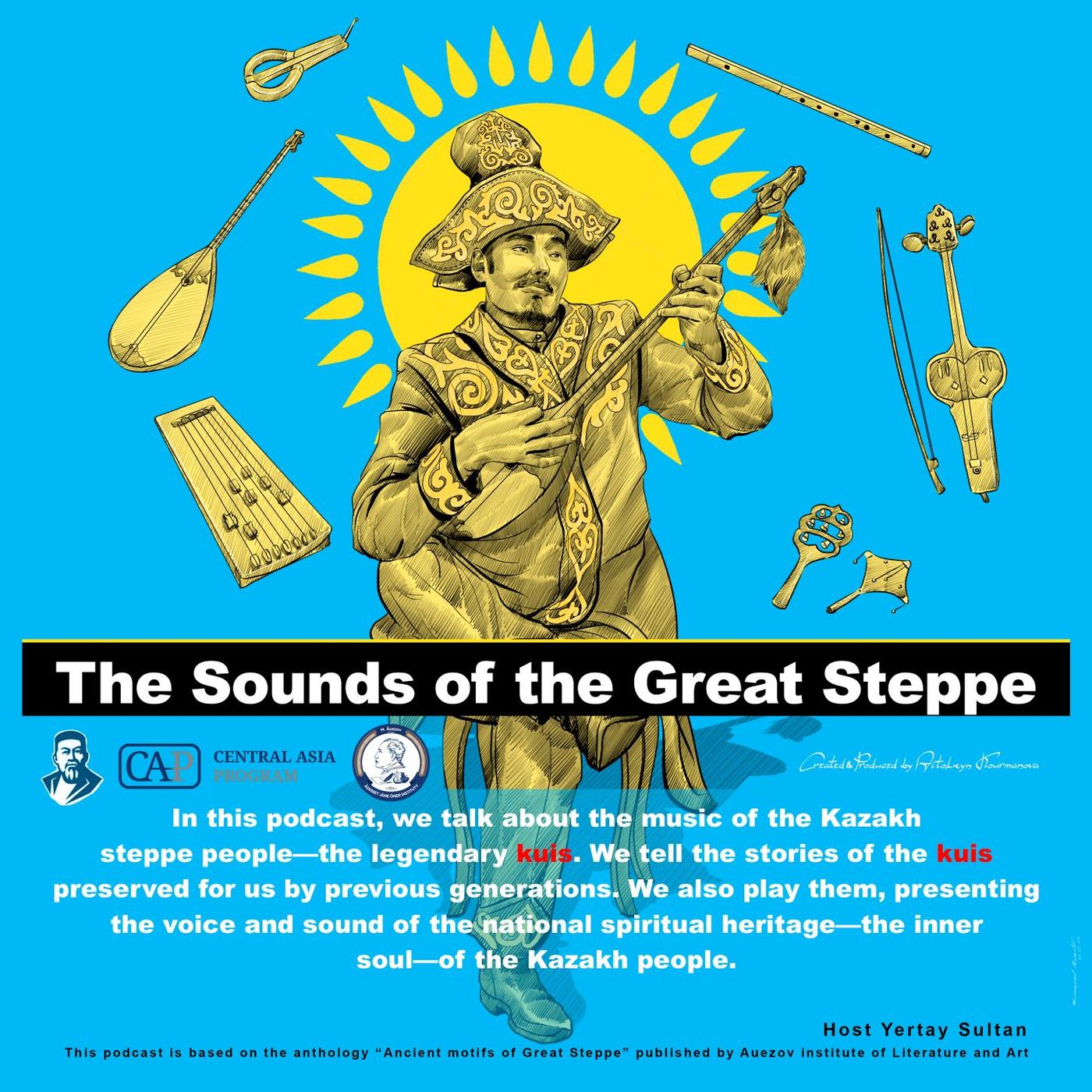
In this podcast, we talk about the music of the Kazakh people—the legendary kuis. We tell the stories of the kuis preserved for us by previous generations. We also play them, presenting the voice and sound of the national spiritual heritage—the inner soul—of the Kazakh people. Created&Produced by Aitolkyn Kourmanova
Nurgisa Atabayuly Tlendiev (1925-1998) is a famous Kazakh composer, national hero, musical virtuoso, founder of the ethnic orchestra group "Otrar sazy," and veteran of the Great Patriotic War. Tlendiev’s most significant contribution to Kazakh music was that he made an ancient Kazakh musical instrument sound in a new way. He founded—and long directed—the ethnic orchestra group “Otrar sazy.” Its musicians played the most ancient Kazakh instruments, including zhetygen, shankobyz, syrnai, and tuyaktas, to name but a few.
Today, we are going to present to you three of his most famous works: “Ata Tolgauy” (Thoughts of the Aged Man), “Akku” (The White Swan), and “Zhekpe-zhek” (The Duel). Notably, the first two compositions were played by Nurgisa Tlendiyev himself. These records were preserved in the manuscript archive of the M. Auezov Institute of Literature and Art and included (with notes) in the anthology The Ancient Motifs of the Great Steppe.
This podcast is based on the anthology Ancient Motifs of the Great Steppe, published by the Auezov Institute of Literature and Art, http://auezovinstitute.kz/
Many Kazakh women kuishi were wonderful performers but alas, their names have been mostly lost to history. However, the career and talent of Dina Nurpeisova, a famous Kazakh composer, flourished under more modern conditions, namely those of 20th-century Soviet Kazakhstan.
Today we will play three of Dina’s famous kuis: “Nauysky” (sometimes called Navoi and dedicated to Uzbek poet and philosopher Alisher Navoi), “Ottin dauren” (Passing Generation) and “Karakaska at” (Black Horse with a White Forehead Mark).
This podcast is based on the anthology Ancient Motifs of the Great Steppe, published by the Auezov Institute of Literature and Art, http://auezovinstitute.kz/
The three-string dombyra is a variation on the classic two-string dombyra. It was especially popular in the Chingistau kui tradition, which developed in the creative works of Abai Kunanbayev and his followers.
Today, we will play a kui Tolgau by Zharkyn Shakarim, a folk kui Kabanbay, and ToryJorga, kui written by Abai.
This podcast is based on the anthology Ancient Motifs of the Great Steppe, published by the Auezov Institute of Literature and Art, http://auezovinstitute.kz/
Tattimbet Kazangapuly is a cult Kazakh kuishi. It was said that he used his dombra as a psychotherapeutic tool—with the help of soulful music, he could bring the listener out of severe depression. And sometimes, he played so fervently that even the horses began to dance.
Today we will play all four of his kuis: Bylkyldak, Kosbasar, Sarzhalau, and Kokeikisti.
This podcast is based on the anthology Ancient Motifs of the Great Steppe, published by the Auezov Institute of Literature and Art, http://auezovinstitute.kz/
Ykhlas Dukenuly (1843-1916) is the founder of the Kazakh classical kui tradition on kylkobyz. We will play three of his most famous kuis: Shynyrau, Airayktyn ashy, and Kambar Batyr.
This episode is about shankobyz, one of the most ancient Kazakh musical instruments. It has a distinctive sound associated with antiquity—perhaps because similar instruments vibrated by breath can be found in the musical culture of many other nations. We will play three halyq kuis: Qyz muny, Anshynyn zary, Sary Arqa.
This podcast is based on the anthology Ancient Motifs of the Great Steppe, published by the Auezov Institute of Literature and Art, http://auezovinstitute.kz/
This episode is about kuis that are played on the dombyra. Dombyra is the most popular Kazakh musical instrument. We will play the most popular dombyra kui - Adai
This podcast is based on the anthology Ancient Motifs of the Great Steppe, published by the Auezov Institute of Literature and Art, http://auezovinstitute.kz/
This episode is about Kurmangazy, one of the greatest kuishi, Kazakh folk musician and composer, who had a great influence on the development of Kazakh musical culture. We will play four of his most famous kuis: Saryarka, Eski Bulbul, Serper, and Toremurat.
This podcast is based on the anthology Ancient Motifs of the Great Steppe, published by the Auezov Institute of Literature and Art, http://auezovinstitute.kz/
This episode is about Dauletkerey, “ancestor of the tore kui,” who left beautiful melodic kuis, forming his own individual school. We will play four of his most famous kuis: Zhiger, Korkem Hanym, Korugly, and Angshylyq.
This podcast is based on the anthology Ancient Motifs of the Great Steppe, published by the Auezov Institute of Literature and Art, http://auezovinstitute.kz/
This episode is about kuis that are played on kobyz, a string instrument, spread among Kazakhs, Karakalpaks, Bashkirs, and Tatars. We will play two kobyz kuis - Munlyk – Zarlyk and Akku.
This podcast is based on the anthology Ancient Motifs of the Great Steppe, published by the Auezov Institute of Literature and Art, http://auezovinstitute.kz/